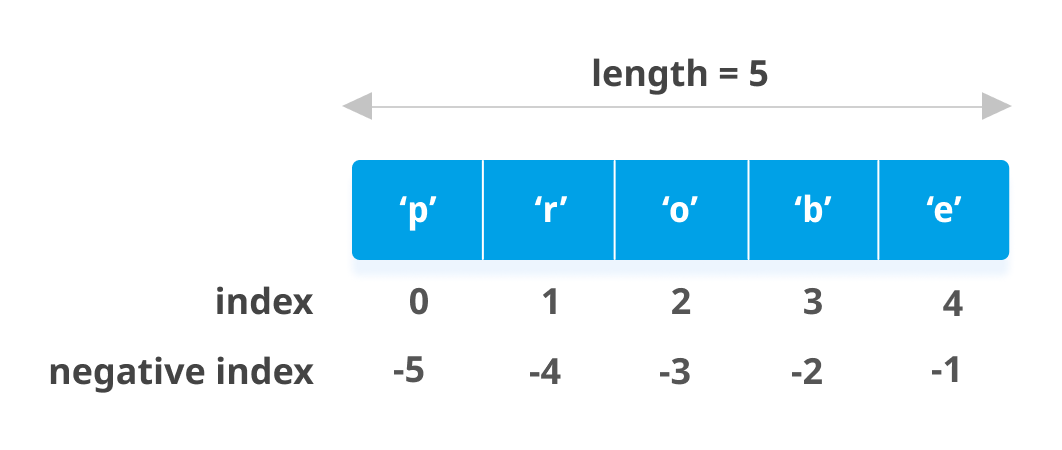Python List
在本文中,我们将学习有关 Python 列表,它们如何创建,列表切片,从中添加或删除元素等所有知识。
Python 提供了一系列通常称为序列的复合数据类型。 List是 Python 中使用最频繁且用途最广泛的数据类型之一。
# a list of programming languages
['Python', 'C++', 'JavaScript']如何建立Python列表?
在 Python 编程中,通过将所有项目(元素)放在方括号 [], 中并用逗号分隔来创建列表。
# list of integers
my_list = [1, 2, 3]它可以具有任意数量的项目,并且它们可以具有不同的类型(整数,浮点数,字符串等)。
# empty list
my_list = []
# list with mixed data types
my_list = [1, "Hello", 3.4]一个列表也可以将另一个列表作为项目。 这称为嵌套列表。
# nested list
my_list = ["mouse", [8, 4, 6], ['a']]如何访问列表中的元素?
我们可以通过多种方式访问列表的元素。
List Index
列表索引
我们可以使用索引运算符[]访问列表中的项目。 在 Python 中,索引从 0 开始。因此,包含 5 个元素的列表的索引从 0 到 4。
尝试访问除这些以外的索引将引发IndexError。 索引必须是整数。 我们不能使用float或其他类型,这将导致TypeError。
使用嵌套索引访问嵌套列表。
my_list = ['p', 'r', 'o', 'b', 'e']
# first item
print(my_list[0]) # p
# third item
print(my_list[2]) # o
# fifth item
print(my_list[4]) # e
# Nested List
n_list = ["Happy", [2, 0, 1, 5]]
# Nested indexing
print(n_list[0][1])
print(n_list[1][3])
# Error! Only integer can be used for indexing
print(my_list[4.0])输出
p o e a 5 Traceback (most recent call last): File "<string>", line 21, in <module> TypeError: list indices must be integers or slices, not float
负索引
Python 允许对其序列进行负索引。 索引 -1 表示最后一项,-2 表示倒数第二项,依此类推。
# Negative indexing in lists
my_list = ['p','r','o','b','e']
# last item
print(my_list[-1])
# fifth last item
print(my_list[-5])当我们运行上面的程序时,我们将得到以下输出:
e p

如何在 Python 中切片列表?
我们可以使用切片运算符:(冒号)访问列表中的一系列项目。
# List slicing in Python
my_list = ['p','r','o','g','r','a','m','i','z']
# elements from index 2 to index 4
print(my_list[2:5])
# elements from index 5 to end
print(my_list[5:])
# elements beginning to end
print(my_list[:])输出:
['o', 'g', 'r'] ['a', 'm', 'i', 'z'] ['p', 'r', 'o', 'g', 'r', 'a', 'm', 'i', 'z']
Note: 当我们对列表进行切片时,开始索引是包含的,但结束索引是排除的.
例如, my_list[2: 5] 的结果是索引2,3,4对应的元素。
如何更改或添加元素到列表?
列表是可变的,这意味着可以更改它们的元素,而与字符串或元组不同。
我们可以使用赋值运算符(=)更改一个项目或一系列项目。
# Correcting mistake values in a list
odd = [2, 4, 6, 8]
# change the 1st item
odd[0] = 1
print(odd)
# change 2nd to 4th items
odd[1:4] = [3, 5, 7]
print(odd) 输出
[1, 4, 6, 8] [1, 3, 5, 7]
我们可以使用append()方法将一个项目添加到列表中,或者使用extend()方法将多个项目添加到列表中。
# Appending and Extending lists in Python
odd = [1, 3, 5]
odd.append(7)
print(odd)
odd.extend([9, 11, 13])
print(odd)Output
[1, 3, 5, 7] [1, 3, 5, 7, 9, 11, 13]
我们还可以使用+运算符组合两个列表。 这也称为连接。
*操作符将列表重复给定的次数。
# Concatenating and repeating lists
odd = [1, 3, 5]
print(odd + [9, 7, 5])
print(["re"] * 3)Output
[1, 3, 5, 9, 7, 5] ['re', 're', 're']
此外,我们可以使用insert()方法在所需位置插入一项,也可以通过将其压缩到列表的空切片中来插入多项。
# Demonstration of list insert() method
odd = [1, 9]
odd.insert(1,3)
print(odd)
odd[2:2] = [5, 7]
print(odd)Output
[1, 3, 9] [1, 3, 5, 7, 9]
如何从列表中删除元素?
我们可以使用关键字del从列表中删除一个或多个项目。 它甚至可以完全删除列表。
# Deleting list items
my_list = ['p', 'r', 'o', 'b', 'l', 'e', 'm']
# delete one item
del my_list[2]
print(my_list)
# delete multiple items
del my_list[1:5]
print(my_list)
# delete the entire list
del my_list
# Error: List not defined
print(my_list)Output
['p', 'r', 'b', 'l', 'e', 'm'] ['p', 'm'] Traceback (most recent call last): File "<string>", line 18, in <module> NameError: name 'my_list' is not defined
我们可以使用remove()方法删除给定项,或使用pop()方法删除给定索引处的项。
如果未提供索引,则pop()方法将删除并返回最后一项。 这有助于我们将列表实现为栈(先进先出数据结构)。
我们也可以使用clear()方法清空列表。
my_list = ['p','r','o','b','l','e','m']
my_list.remove('p')
# Output: ['r', 'o', 'b', 'l', 'e', 'm']
print(my_list)
# Output: 'o'
print(my_list.pop(1))
# Output: ['r', 'b', 'l', 'e', 'm']
print(my_list)
# Output: 'm'
print(my_list.pop())
# Output: ['r', 'b', 'l', 'e']
print(my_list)
my_list.clear()
# Output: []
print(my_list)Output
['r', 'o', 'b', 'l', 'e', 'm'] o ['r', 'b', 'l', 'e', 'm'] m ['r', 'b', 'l', 'e'] []
最后,我们还可以通过为元素切片分配一个空列表来删除列表中的项目。
>>> my_list = ['p','r','o','b','l','e','m']
>>> my_list[2:3] = []
>>> my_list
['p', 'r', 'b', 'l', 'e', 'm']
>>> my_list[2:5] = []
>>> my_list
['p', 'r', 'm']Python 列表方法
Python 有许多有用的列表方法,使得使用列表变得非常容易. 下面列出了 Python 编程中列表对象可用的方法。
|
列表方法 |
描述 |
|---|---|
| append() | 在列表的末尾添加元素 |
| extend() | 将列表的所有元素添加到另一个列表 |
| insert() | 在定义的索引处插入项目 |
| remove() | 从列表中删除一个项目 |
| pop() | 删除并返回给定索引的元素 |
| clear() | 从列表中删除所有项目 |
| index() | 返回第一个匹配项的索引 |
| count() | 返回作为参数传递的项目数的计数 |
| sort() | 列表中的项目以升序排序 |
| reverse() | 反转列表 |
| copy() | 返回列表的浅表副本 |
# Example on Python list methods
my_list = [3, 8, 1, 6, 8, 8, 4]
# Add 'a' to the end
my_list.append('a')
# Output: [3, 8, 1, 6, 8, 8, 4, 'a']
print(my_list)
# Index of first occurrence of 8
print(my_list.index(8)) # Output: 1
# Count of 8 in the list
print(my_list.count(8)) # Output: 3 列表推导式:创建新列表的优雅方式
列表推导式是从 Python 现有列表创建新列表的一种简洁明了的方法。
列表推导由方括号内的语句的表达式和组成。
这是一个列出每项增加 2 的幂的示例。
pow2 = [2 ** x for x in range(10)]
print(pow2)Output
[1, 2, 4, 8, 16, 32, 64, 128, 256, 512]
此代码等效于:
pow2 = []
for x in range(10):
pow2.append(2 ** x)列表推导可以选择包含更多的for或if语句。 可选的if语句可以过滤出新列表的项目。 这里有些例子。
>>> pow2 = [2 ** x for x in range(10) if x > 5]
>>> pow2
[64, 128, 256, 512]
>>> odd = [x for x in range(20) if x % 2 == 1]
>>> odd
[1, 3, 5, 7, 9, 11, 13, 15, 17, 19]
>>> [x+y for x in ['Python ','C '] for y in ['Language','Programming']]
['Python Language', 'Python Programming', 'C Language', 'C Programming']
Python 中的其他列表操作
列表成员资格测试
我们可以使用关键字in来测试列表中是否存在某项。
my_list = ['p', 'r', 'o', 'b', 'l', 'e', 'm']
# Output: True
print('p' in my_list)
# Output: False
print('a' in my_list)
# Output: True
print('c' not in my_list)Output
True False True
遍历列表
使用for循环,我们可以遍历列表中的每个项目。
for fruit in ['apple','banana','mango']:
print("I like",fruit)Output
I like apple I like banana I like mango

